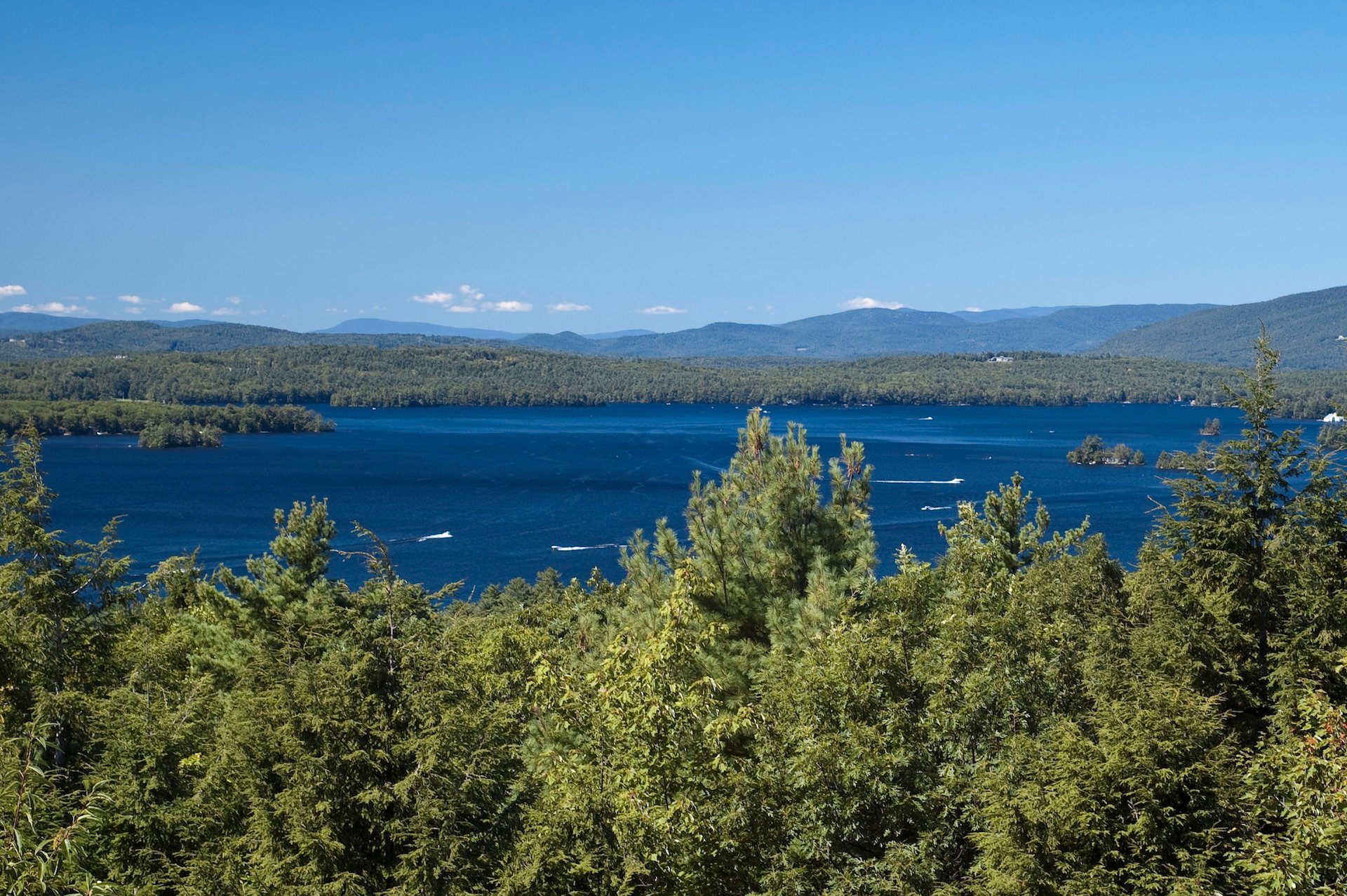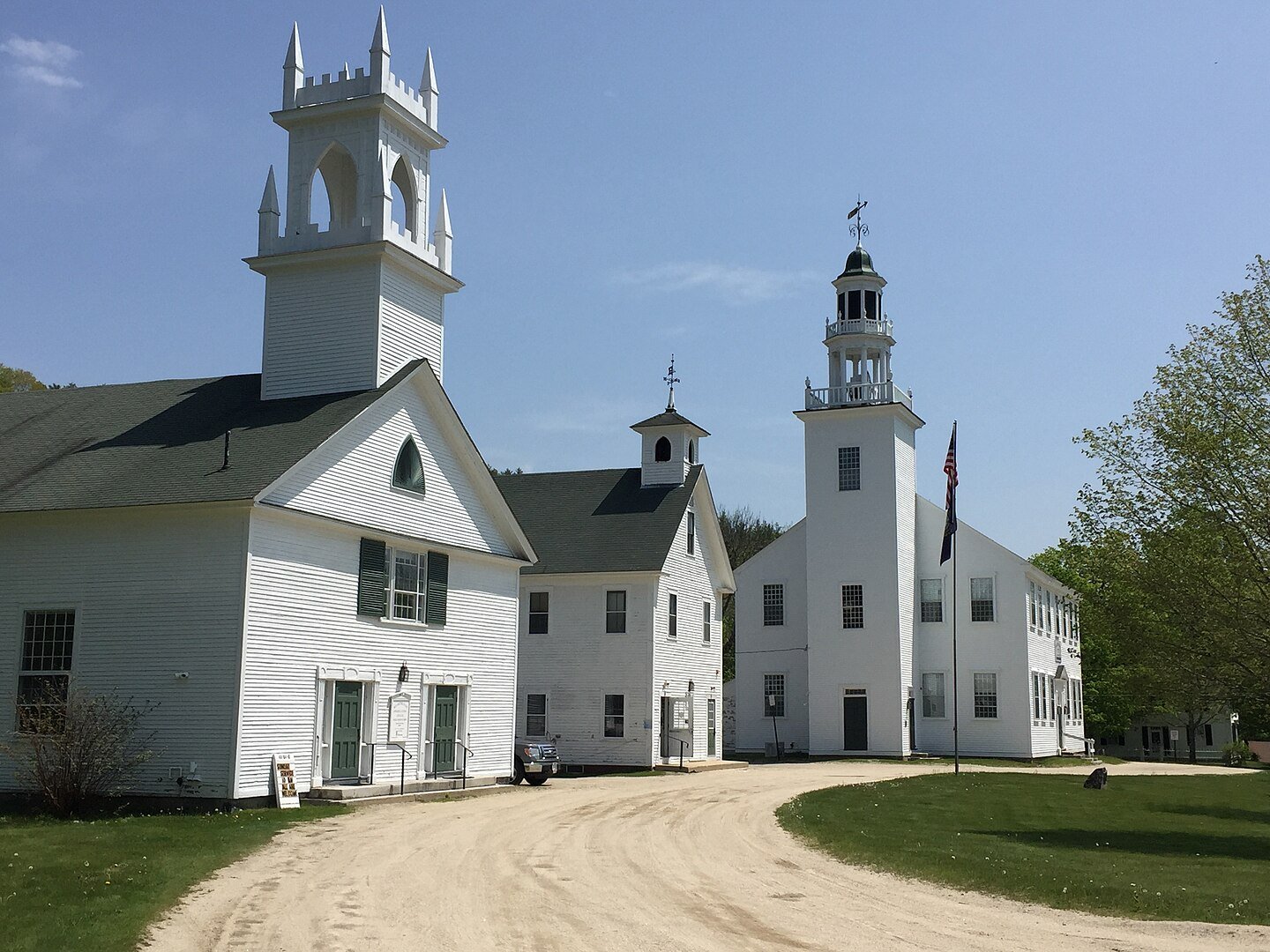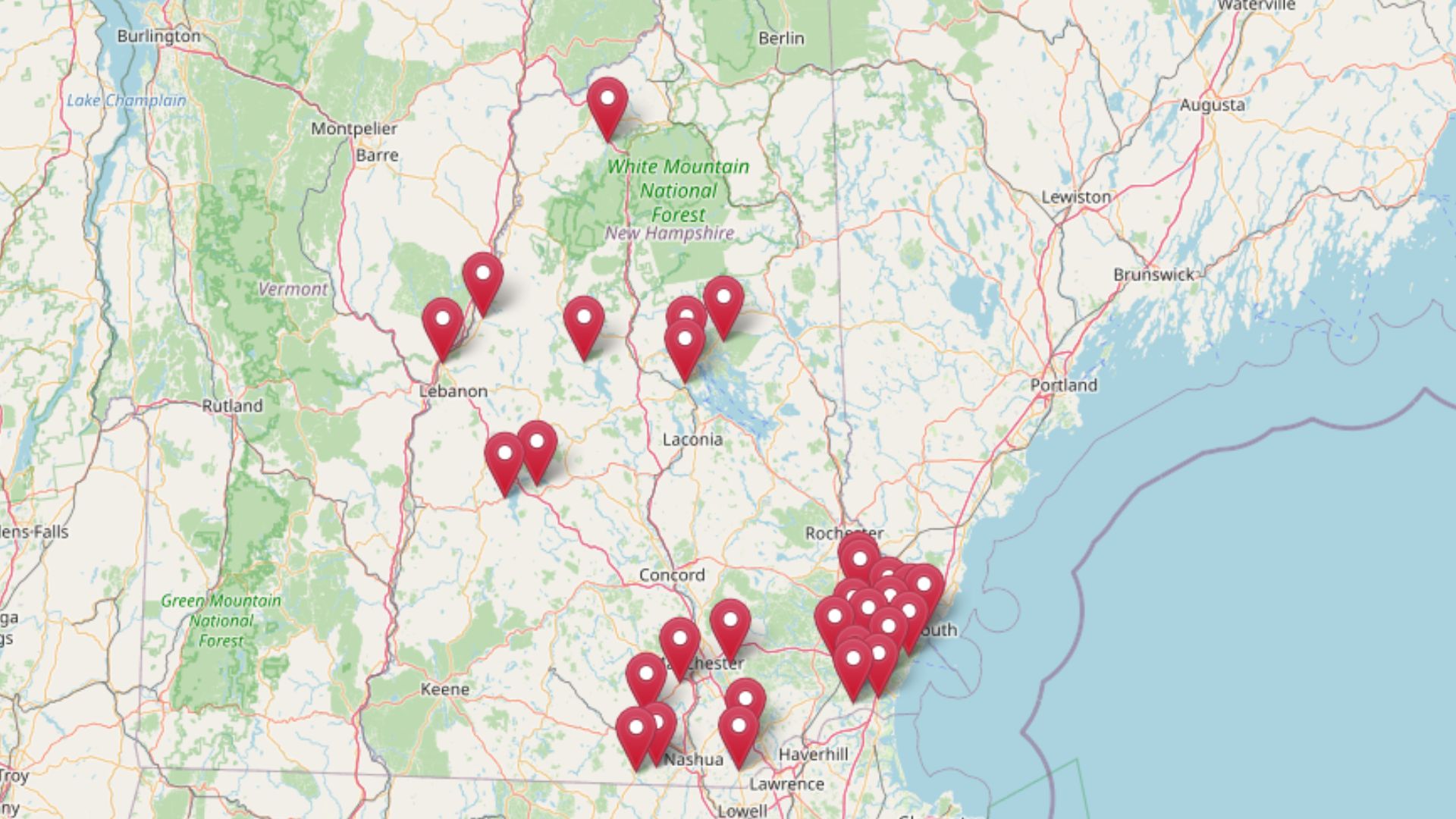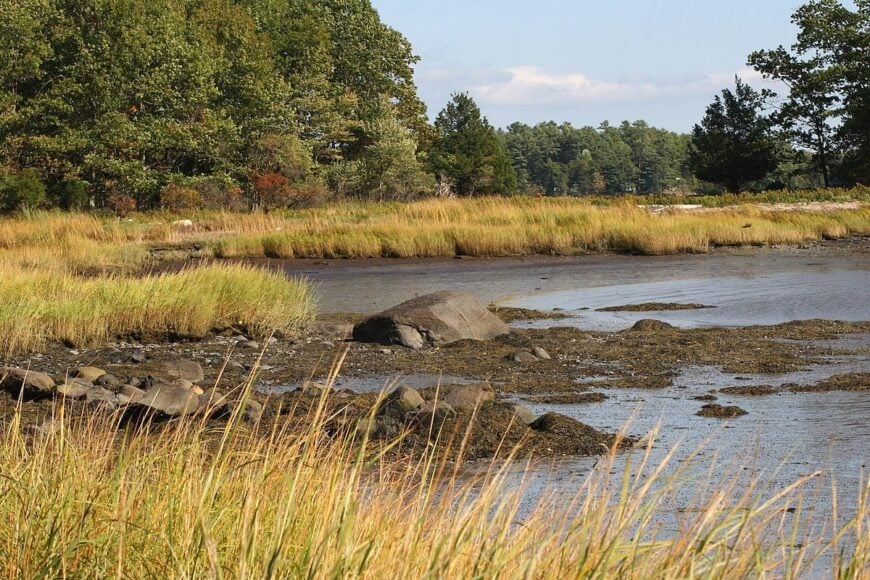
Southeast New Hampshire is shaped by a mix of tidal waters, inland rivers, and modest hills that fade into forest. Between its better-known cities, small towns cluster along backroads, harbors, and mill ponds, each holding its own sense of scale and pace. The region’s variety comes from how land and water meet, whether in marshes edged with cordgrass or in stretches of farmland framed by old stone walls.
Many of these towns grew from shipbuilding, fishing, or textile milling, and their streets still follow the lines set centuries ago. The buildings are a record of those beginnings — brick mill blocks on the river, clapboard homes facing narrow lanes, and simple meetinghouses set on greens that remain in use. In some places, the industry is gone, but the structures remain as anchors for new uses.
The proximity to the coast shapes more than just the view. Saltwater reaches far inland through bays and rivers, creating tidal landscapes that shift with the day. These waterways once carried goods and people; now they carry kayaks and fishing skiffs, but the sense of connection remains.
Travel through this part of New Hampshire is not about long distances but about small changes. A few miles can take you from a sheltered cove to an inland ridge, from a cluster of historic storefronts to a stretch of road where forest closes in on both sides. Each town on this list occupies its own distinct piece of that varied geography.
25. Rye: Coastal Quiet Beyond the Crowds
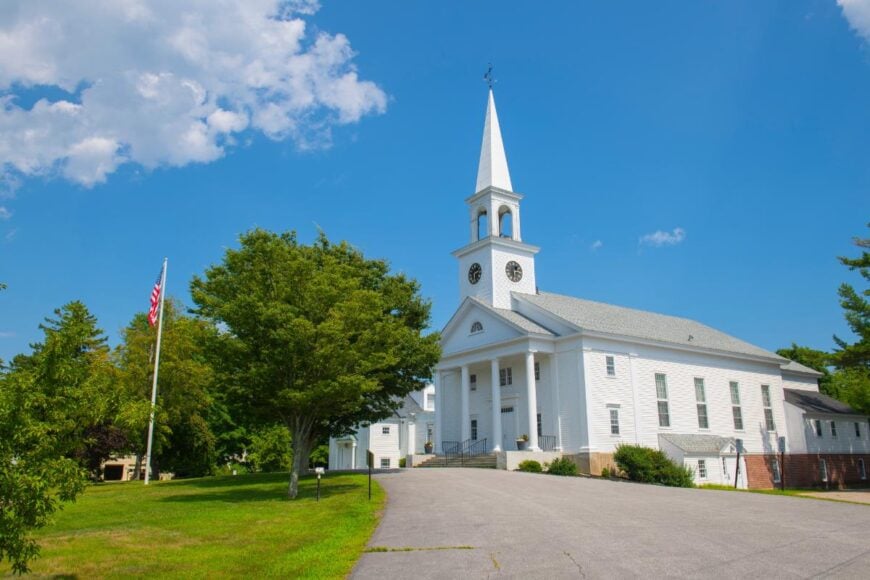
Set along New Hampshire’s rocky seacoast, Rye feels like a place where the ocean sets the rhythm of life. Tucked between stretches of salt marsh and quiet beaches, it stays just far enough from busier coastal towns to keep its peaceful character.
The air carries the scent of salt and pine, and the sound of waves mingles with seabirds overhead. Visitors wander sandy paths to Jenness State Beach, explore Odiorne Point’s tidal pools, or take in the view from Rye Harbor.
Fishing and lobstering remain part of the town’s working waterfront, blending with its role as a haven for summer cottages and year-round retreats. In Rye, the coastline feels timeless, and the quiet lingers long after the tide goes out.
Where is Rye?
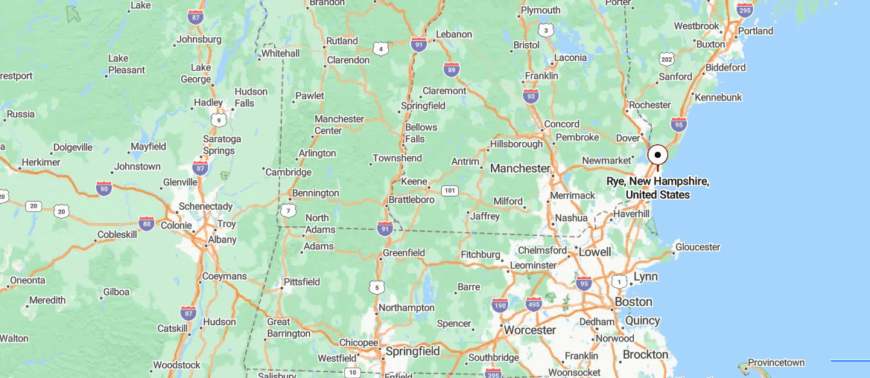
Rye rests along New Hampshire’s short but striking seacoast, in the southeastern part of the state. It’s about 5 miles south of Portsmouth and roughly 50 miles north of Boston, reached by following U.S. Route 1 or the scenic Ocean Boulevard that traces the shoreline.
The drive offers glimpses of rocky beaches, salt marshes, and the Atlantic stretching out beside you. It’s close enough to reach with ease, yet its ocean breeze and coastal quiet make it feel worlds away.
24. New Castle: Island Seclusion with Colonial Charm

Perched on a cluster of small islands at the mouth of the Piscataqua River, New Castle feels like a world apart from the New Hampshire mainland. Reached by a single causeway, it’s surrounded by rocky shores, tidal inlets, and the ever-changing Atlantic.
The village streets are narrow and lined with historic homes, some dating back to the 1600s, giving the town an enduring sense of place. Days here might be spent walking the grounds of Fort Constitution, kayaking along sheltered coves, or watching sailboats drift past from Great Island Common.
Tourism and a touch of maritime trade blend with a quiet residential life. In New Castle, the sea is never far, and the sense of calm feels as constant as the tide.
Where is New Castle?

New Castle sits on a small island at the southeastern tip of New Hampshire, connected to the mainland by a short causeway. It’s about 3 miles east of Portsmouth and roughly 55 miles north of Boston, reached by following coastal roads that pass through neighboring towns before crossing the water.
The approach offers views of historic homes, tidal inlets, and the open Atlantic beyond. It’s a place where the sea surrounds you, and the rest of the world feels just out of reach.
23. Greenland: Open Fields and Historical Roots
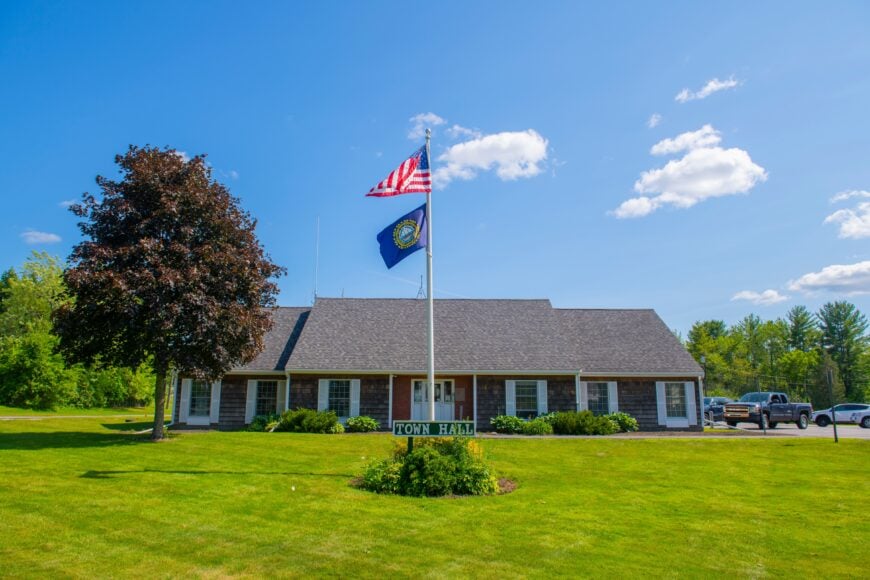
Set just inland from New Hampshire’s seacoast, Greenland feels quietly removed yet close enough to hear the distant call of gulls on the wind. Surrounded by rolling farmland, salt marshes, and wooded backroads, it sits apart from busier coastal towns while keeping the ocean within easy reach.
The village center holds historic buildings, a white-steepled church, and gathering spots where neighbors linger to talk. Nearby, Great Bay offers kayaking, birdwatching, and scenic trails that change with the seasons.
Farming and small local businesses remain part of daily life, blending past and present. In Greenland, the pace is gentle, and the sense of place feels rooted in both land and water.
Where is Greenland?

Greenland is located in the southeastern part of New Hampshire, just inland from the coast. It’s about 5 miles west of Portsmouth and roughly 55 miles north of Boston, reached by following Interstate 95 or U.S. Route 33 through gentle stretches of farmland.
The drive passes open fields, quiet neighborhoods, and patches of forest that hint at the seacoast just beyond. It’s close to everything, yet its calm, rural setting makes it feel pleasantly removed.
22. Hampton Falls: Farmland by the Coast
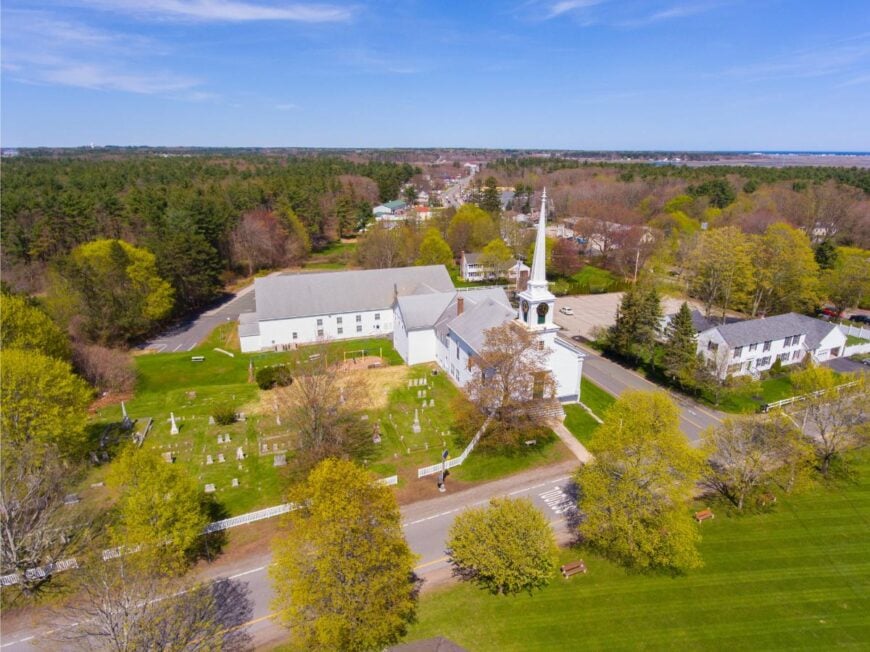
Surrounded by orchards, fields, and winding country roads, Hampton Falls sits quietly just inland from New Hampshire’s seacoast. Its distance from major highways keeps the pace slow, while the scent of apple blossoms and hay fields drifts through the air in season.
The village green, white-steepled church, and historic homes give the town a timeless charm. Visitors come for autumn apple picking, roadside farm stands, and drives through the countryside that blaze with color in fall.
Small farms and local businesses shape the economy, carrying on traditions that have lasted for generations. In Hampton Falls, the calm feels deliberate, as if the town has chosen to keep the outside world at arm’s length.
Where is Hampton Falls?

Hampton Falls lies in southeastern New Hampshire, just a few miles inland from the Atlantic coast. It’s about 4 miles south of Hampton Beach and roughly 50 miles north of Boston, reached by following U.S. Route 1 or Interstate 95 through rolling farmland and small-town scenery.
The approach takes you past orchards, historic homes, and open fields that change with the seasons. It’s near enough for an easy visit, yet its quiet charm makes it feel far from the bustle.
21. Seabrook: Quiet Corners Beyond the Retail Strip
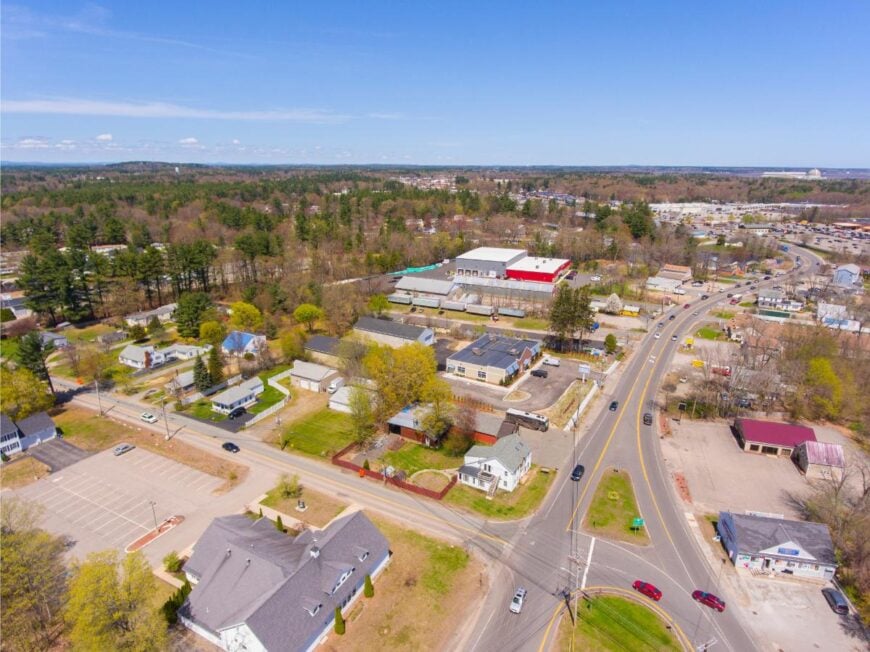
Set along New Hampshire’s southernmost stretch of coastline, Seabrook balances a quiet, small-town core with the pull of the open Atlantic. Just beyond its main streets, sandy beaches and tidal marshes spread out under wide skies, while working docks hint at the town’s fishing heritage.
Life here moves between the rhythm of the sea and the steady presence of local shops, diners, and gathering spots. Visitors stroll along Seabrook Beach, launch boats from the harbor, or explore the marshlands teeming with shorebirds.
Fishing and small-scale industry remain part of the town’s backbone, blending with a community rooted in tradition. In Seabrook, the ocean is never far, and the salt air feels like part of everyday life.
Where is Seabrook?
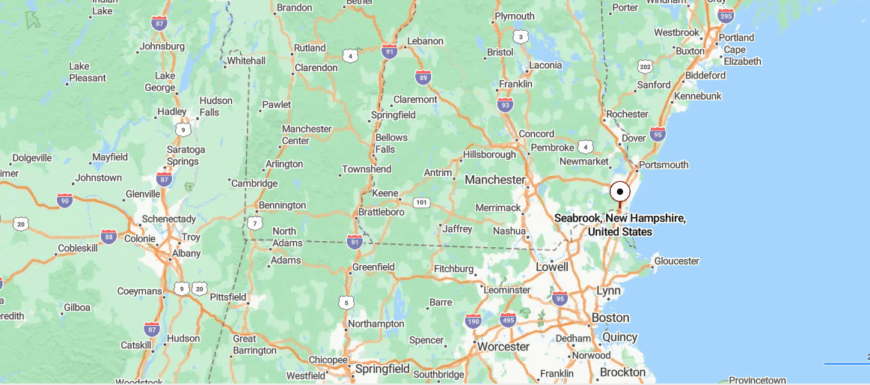
Seabrook is set along New Hampshire’s southern seacoast, right at the Massachusetts border. It’s about 15 miles south of Portsmouth and roughly 50 miles north of Boston, reached by traveling on Interstate 95 or U.S. Route 1 through a mix of coastal marshland and small-town roads.
The drive offers views of tidal flats, sandy stretches, and fishing boats moored near the harbor. It’s close to major routes, yet the salt air and shoreline quiet give it a world-apart feeling.
20. Exeter: Historic Heart with Hidden Retreats

Set along the banks of the Exeter River, this historic New Hampshire town feels both quietly tucked away and deeply connected to its past. Brick sidewalks, colonial-era buildings, and shaded commons create a timeless atmosphere in the center of town.
Just beyond, tree-lined backroads lead to hidden trails, riverside parks, and views of the tidal Squamscott River. Visitors explore the American Independence Museum, wander through local shops, or enjoy seasonal farmers’ markets on the green.
Education and small businesses anchor the community, with Phillips Exeter Academy lending a scholarly rhythm to daily life. In Exeter, history and nature meet in a way that makes the present feel slower, and the past comfortably close.
Where is Exeter?
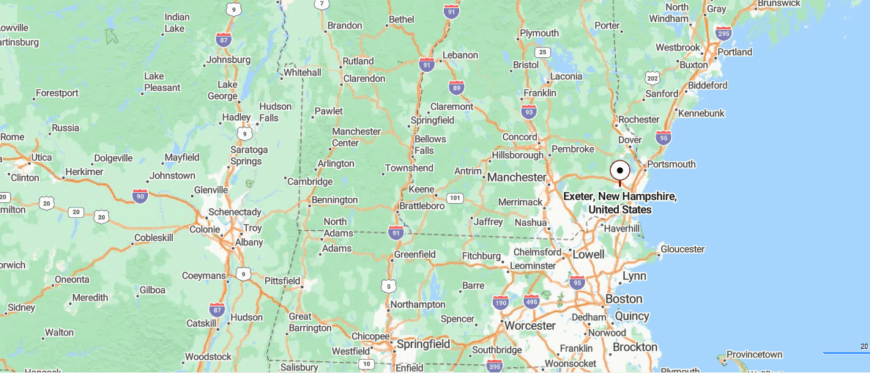
Exeter is located in southeastern New Hampshire, a short distance inland from the coast. It’s about 10 miles west of Hampton Beach and roughly 50 miles north of Boston, reached by traveling on NH Route 101 or U.S. Route 4 through a mix of wooded stretches and historic town centers.
The approach passes colonial-era architecture, shaded streets, and the winding Squamscott River. It’s well-connected, yet its timeless charm and slower rhythm make it feel pleasantly apart from the rush.
19. Durham: University Town with Hidden Corners
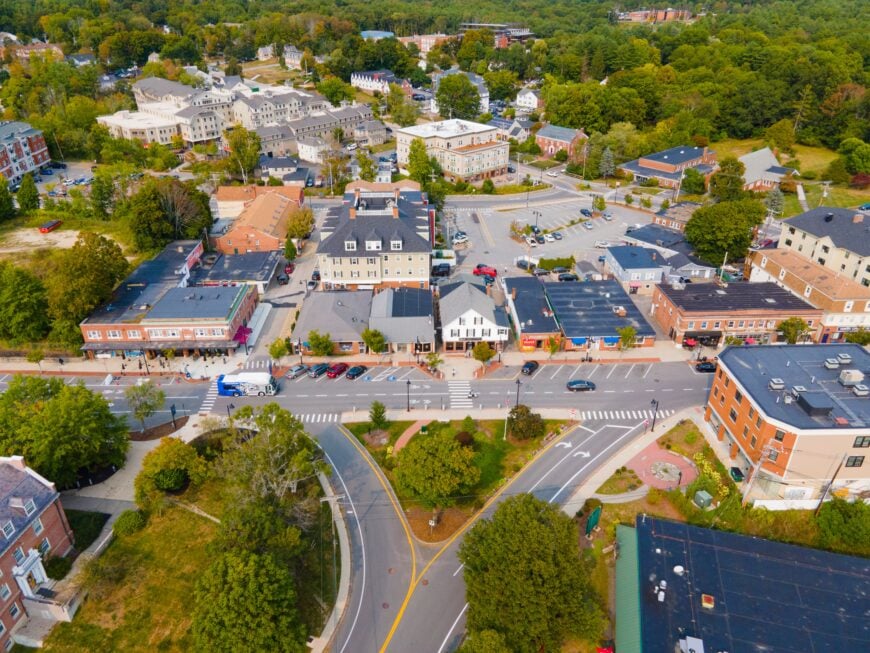
Framed by forested hills and the tidal waters of the Oyster River, Durham feels quietly set apart while still holding a vibrant undercurrent of life. Its tree-lined streets and historic buildings give the town a timeless character, while trails, marshes, and riverbanks offer easy escapes into nature.
The University of New Hampshire shapes much of the local rhythm, bringing a blend of academic energy and small-town familiarity. Days here might be spent kayaking on Great Bay, walking the College Woods trails, or exploring the shops and cafés downtown.
Farming, education, and research all weave into the local economy. In Durham, the calm of the countryside and the vitality of a college town meet in a balance that feels both grounded and alive.
Where is Durham?
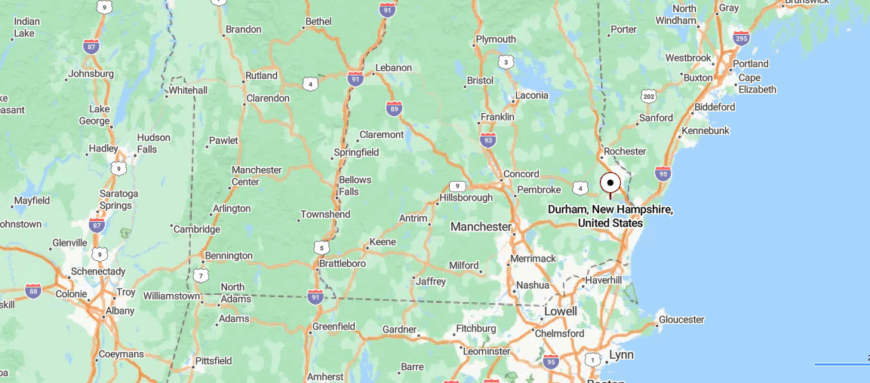
Durham sits in southeastern New Hampshire, along the Oyster River and close to the Great Bay estuary. It’s about 12 miles west of Portsmouth and roughly 60 miles north of Boston, reached by following U.S. Route 4 through wooded landscapes and small-town scenery.
The drive takes you past forested hills, quiet neighborhoods, and glimpses of tidal waters. It’s an easy trip from the city, yet the blend of river views and campus-town calm makes it feel set apart.
18. Madbury: Wooded Privacy Near the Bay

Tucked between wooded hills and open farmland, Madbury feels like a quiet corner of New Hampshire that has managed to stay off the beaten path. Backroads wind past old farmhouses, maple groves, and fields that shift with the seasons.
The town’s pace is slow, centered on community events, local farms, and the natural rhythm of rural life. Nearby, Bellamy Reservoir offers kayaking, fishing, and peaceful walks along its forested edges.
Farming and small-scale agriculture remain part of the landscape, tying the present to generations past. In Madbury, the quiet feels unbroken, as if the land has been keeping its own gentle time for centuries.
Where is Madbury?

Madbury is located in southeastern New Hampshire, just west of Dover and a few miles from the Great Bay. It’s about 13 miles northwest of Portsmouth and roughly 60 miles north of Boston, reached by following NH Route 155 through wooded backroads and gentle hills.
The approach passes farm fields, quiet neighborhoods, and stretches of forest that open to broad sky. It’s close enough to coastal towns, yet its rural calm makes it feel tucked away from the rest of the world.
17. Rollinsford: Riverside Solitude with Artistic Flair

Set along the Salmon Falls River, Rollinsford blends the feel of a tucked-away New England village with echoes of its mill town past. Brick mill buildings still stand near the water, reminders of when textile production shaped daily life here.
Today, the pace is calmer, with quiet streets, artist studios, and community gatherings at the heart of town life. The river offers spots for fishing, kayaking, and scenic walks along its banks, while nearby farms add to the rural charm.
Small businesses and creative ventures keep the local spirit thriving. In Rollinsford, history flows alongside the river, steady and enduring.
Where is Rollinsford?

Rollinsford sits in southeastern New Hampshire, along the Salmon Falls River at the Maine border. It’s about 5 miles southeast of Dover and roughly 65 miles north of Boston, reached by following NH Route 4 or winding local roads that trace the river.
The drive passes historic mill buildings, tree-lined streets, and stretches of quiet water. It’s a small riverside town where the flowing current and gentle pace make the outside world feel far away.
16. Dover Point: Peninsula Living with Panoramic Views
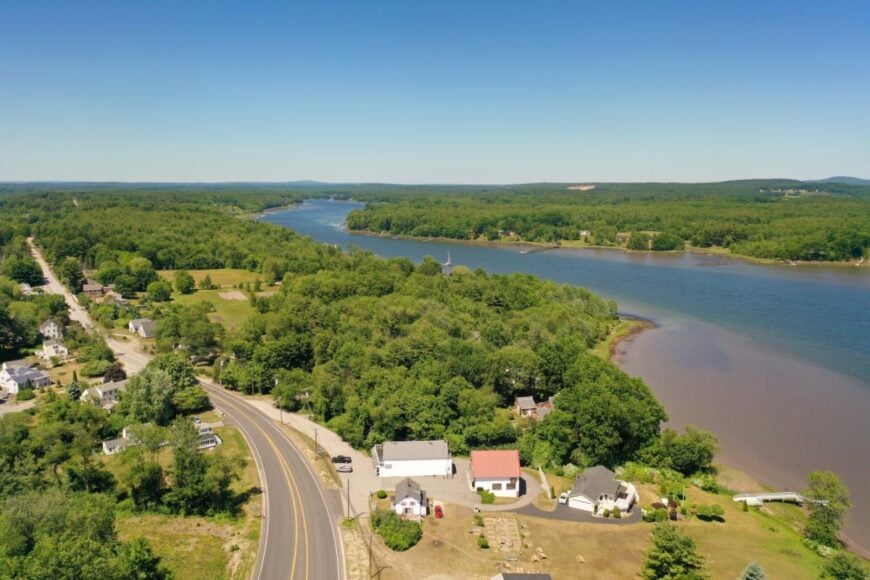
Where the Piscataqua River meets Little Bay, Dover Point feels like a small, hidden pocket of New Hampshire’s seacoast. Surrounded by tidal waters and salt marsh, it sits apart from the busier pace of downtown Dover just a few miles away.
The air is rich with the scent of the sea, and gulls wheel overhead while boats drift along the channels. Days here might be spent fishing from the shoreline, paddling through calm coves, or watching the tide change from a quiet dock.
A mix of year-round homes and seasonal cottages gives the area a relaxed, close-knit feel. In Dover Point, the water is never far, and the horizon always carries a hint of salt and wind.
Where is Dover Point?
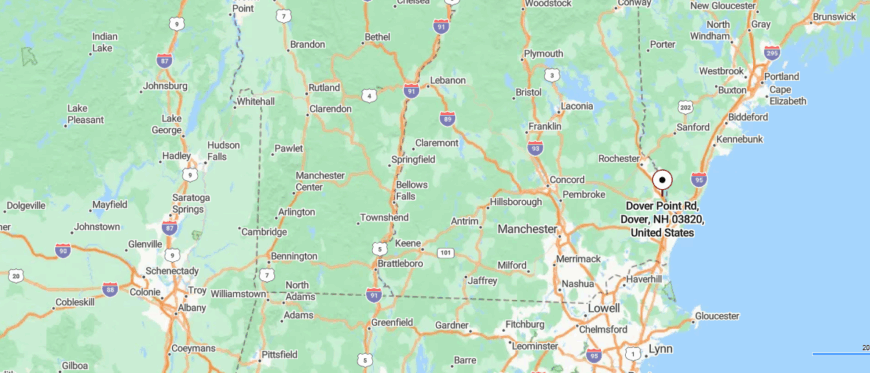
Dover Point is located in southeastern New Hampshire, where the Piscataqua River meets Little Bay. It’s about 8 miles northwest of Portsmouth and roughly 60 miles north of Boston, reached by following U.S. Route 4 or local coastal roads with water views.
The approach takes you past marinas, salt marshes, and stretches of shoreline that shift with the tide. It’s close to larger towns, yet the mix of river breeze and open water gives it a quietly removed feeling.
15. Portsmouth Plains: Hidden Pocket in a Port City
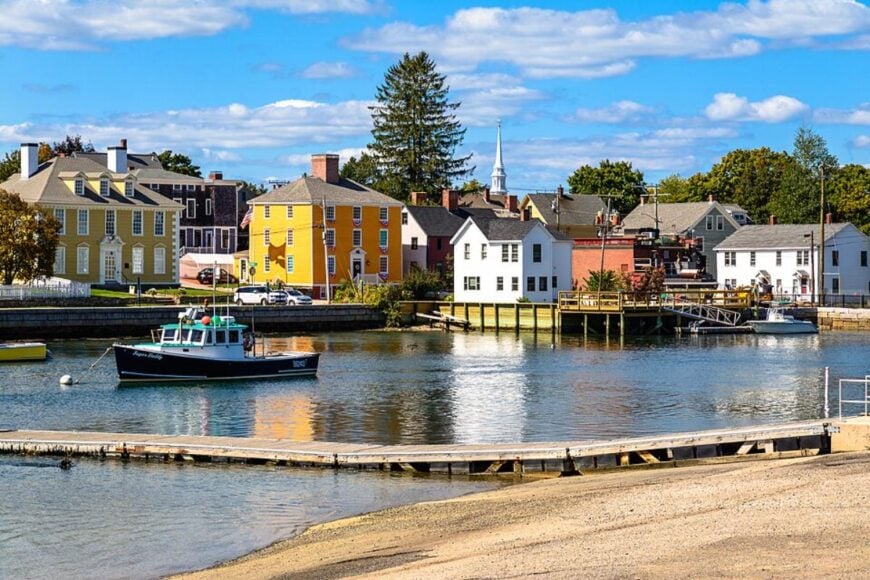
Just west of Portsmouth’s historic downtown, Portsmouth Plains feels like a quieter extension of the city, where open fields once stretched as far as the eye could see. Today, tree-lined streets and historic homes stand alongside remnants of its farming past, giving the area a layered sense of history.
The pace is gentler here, with neighbors crossing paths at local shops, parks, and community gatherings. Nearby, the Piscataqua River and seacoast offer quick escapes for boating, fishing, or scenic walks.
Small businesses and a strong sense of local heritage shape daily life. In Portsmouth Plains, you can feel the nearness of the city while still holding onto a slower, steadier rhythm.
Where is Portsmouth?
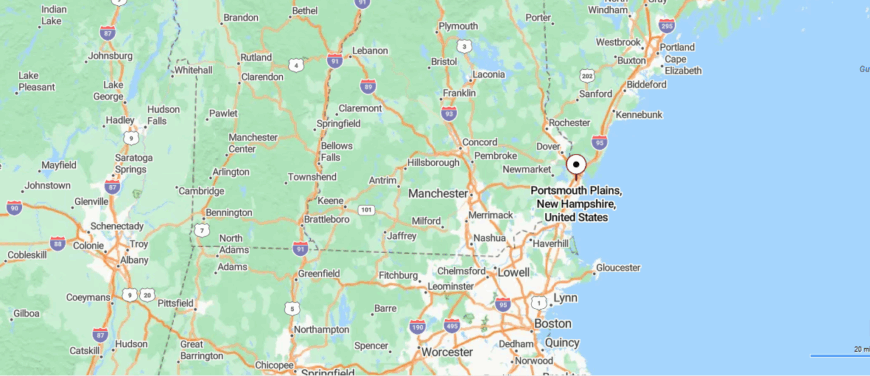
Portsmouth Plains is set in southeastern New Hampshire, just west of downtown Portsmouth. It’s about 55 miles north of Boston and reached by following U.S. Route 1 or Interstate 95 before turning onto local streets lined with historic homes and shaded trees.
The short drive from the city center passes small parks and neighborhood green spaces, giving a sense of calm at the edge of town. It’s near everything, yet its quiet, residential feel makes it seem a step apart from the bustle.
14. Brentwood: Forested Neighborhoods and Open Fields
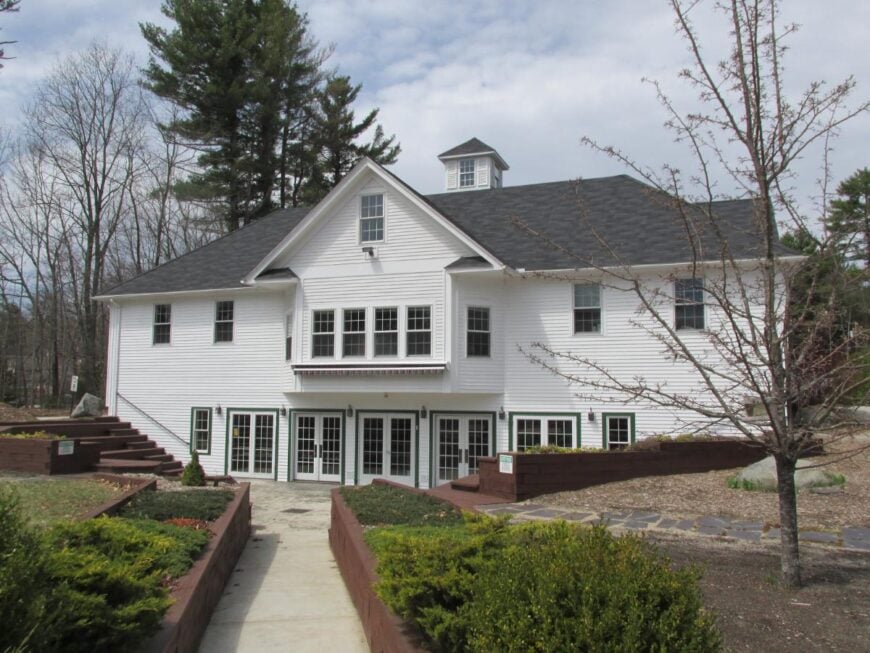
Surrounded by rolling farmland and wooded backroads, Brentwood sits quietly inland from New Hampshire’s seacoast, away from the pull of busy highways. Its village center is small, marked by historic buildings, a white-steepled church, and gathering spots that have served the community for generations.
Life here moves with the seasons—spring planting, summer fairs, autumn foliage, and snowy winter evenings. Outdoor escapes are close by, from trails along the Exeter River to drives through the surrounding countryside.
Farming and small local businesses anchor the town’s economy, keeping its rural roots strong. In Brentwood, the quiet feels intentional, as if the town has chosen to hold onto its slower way of life.
Where is Brentwood?

Brentwood is located in southeastern New Hampshire, a short drive inland from the seacoast. It’s about 6 miles west of Exeter and roughly 55 miles north of Boston, reached by following NH Route 125 through rolling farmland and stretches of forest.
The approach passes open fields, winding creeks, and clusters of historic homes. It’s close to main routes, yet its rural landscape and unhurried pace give it a tucked-away feeling.
13. Newmarket: Riverside Mill Town with a Creative Pulse
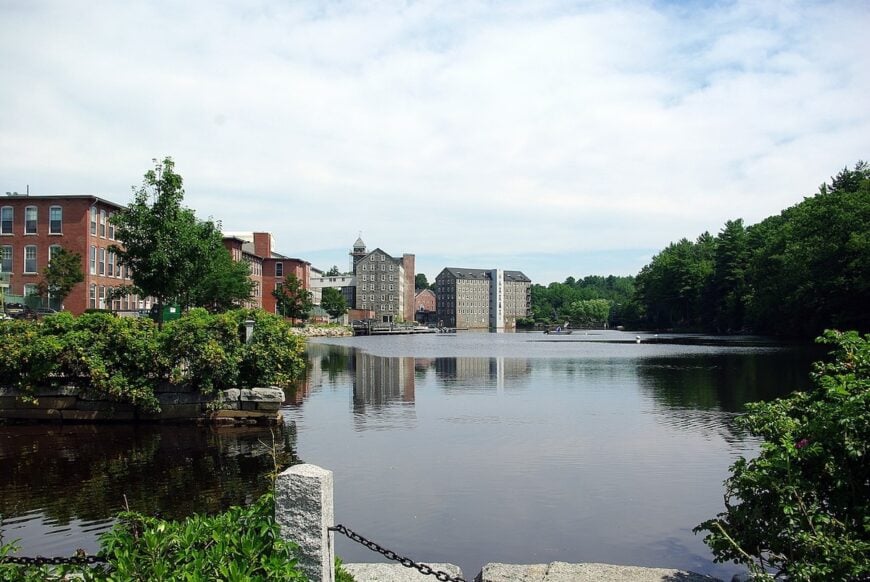
Set along the Lamprey River where it widens toward Great Bay, Newmarket blends historic mill-town grit with a quietly scenic riverside setting. Its red-brick mill buildings, once home to textile production, now house artists’ studios, small shops, and cafés, giving the town an undercurrent of creative energy.
The compact downtown is walkable, lined with 19th-century storefronts that overlook the river’s slow current. Trails wind from the edge of town into wooded conservation areas, while the Lamprey itself draws paddlers, anglers, and photographers in every season.
With a mix of historic architecture, natural beauty, and a laid-back pace, Newmarket manages to feel both connected and removed — a place where community life still revolves around the river.
Where is Newmarket?

Newmarket sits in southeastern New Hampshire, along the Lamprey River just before it meets the tidal waters of Great Bay. It’s about 12 miles west of Portsmouth and roughly 60 miles north of Boston, reached by following NH Route 108 through rolling farmland and small-town stretches.
The drive into town offers glimpses of the river, forested hills, and historic mill buildings rising along the banks. Its location keeps it close to larger hubs, yet the tidal flats, wooded trails, and riverside views make it feel comfortably apart from the rush.
12. Stratham: Rural Living with Easy Access
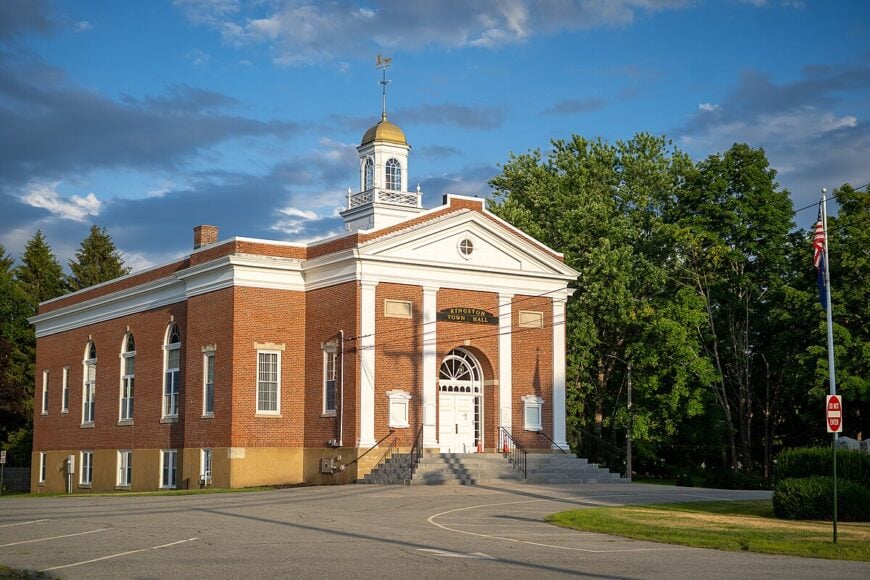
Set between the seacoast and rolling inland hills, Stratham feels both quietly rural and comfortably close to New Hampshire’s busier coastal towns. Fields, wooded trails, and winding roads shape the landscape, while the Squamscott River adds a touch of tidal beauty.
The town’s rhythm moves with community events, from the annual Stratham Fair to seasonal farm markets and gatherings on the town green. Nearby Stratham Hill Park offers hiking, biking, and panoramic views of the countryside.
Farming, small businesses, and a strong sense of local heritage keep the community closely connected. In Stratham, the blend of open space and neighborly spirit makes life feel both grounded and inviting.
Where is Stratham?
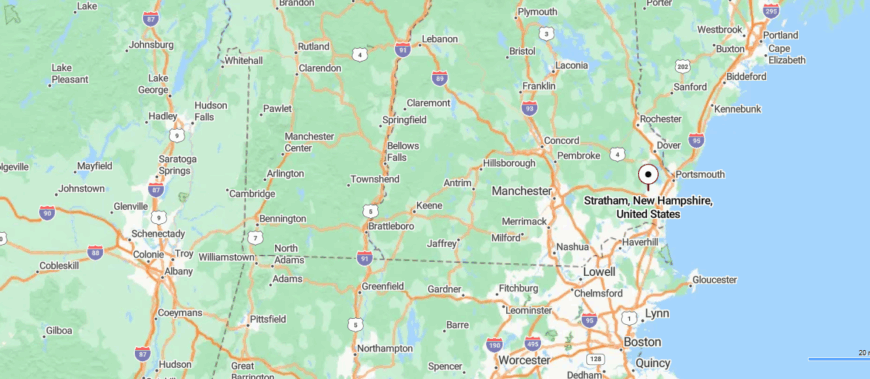
Stratham is located in southeastern New Hampshire, close to the state’s seacoast. It’s about 6 miles southeast of Exeter and roughly 55 miles north of Boston, reached by following NH Route 33 or U.S. Route 108 through farmland and small-town streets.
The approach passes open fields, gentle hills, and glimpses of tidal marshland. It’s well within reach of larger towns, yet its quiet landscapes give it a sense of being set apart.
11. Hampstead: Lakeside Neighborhoods and Quiet Roads
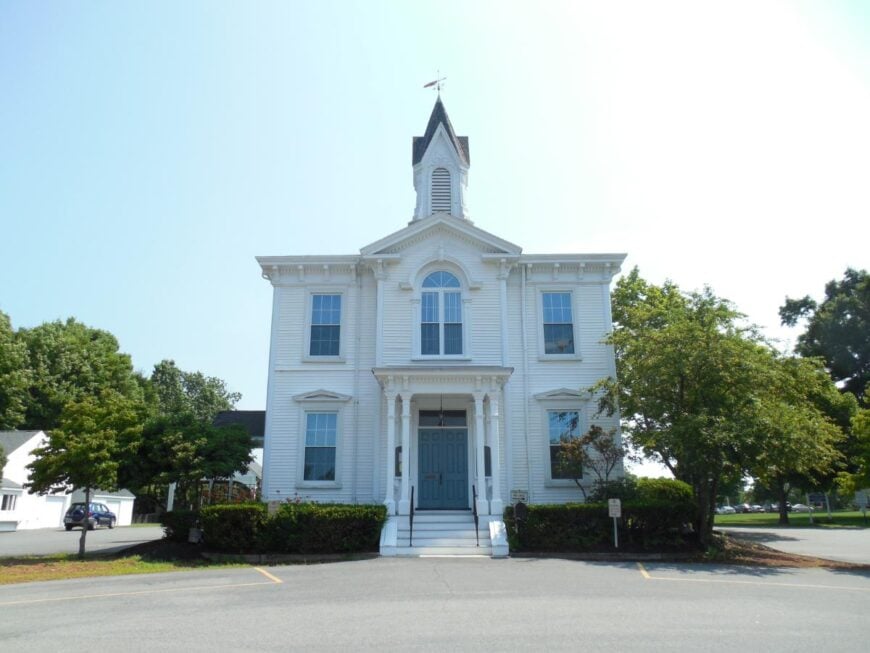
Surrounded by ponds, forests, and winding country roads, Hampstead rests quietly in southern New Hampshire, away from the hum of major highways. Its historic center holds colonial-era homes, a white-steepled church, and gathering spots that have anchored the community for generations.
Life here often revolves around the water—boating on Sunset Lake, fishing in local ponds, or walking shaded trails through conservation land. Seasonal events, from summer concerts to winter holiday gatherings, keep neighbors connected year-round.
Small businesses and a tradition of civic involvement shape the town’s character. In Hampstead, the calm feels lasting, as if the landscape and community have agreed to keep life at a gentler pace.
Where is Hampstead?
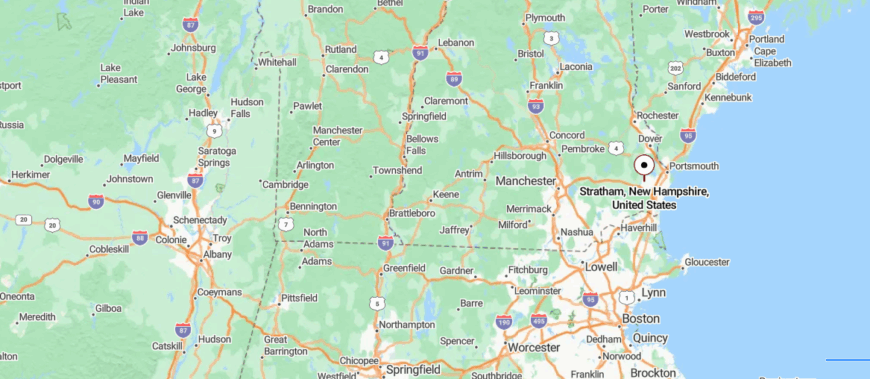
Hampstead sits in southern New Hampshire, near the Massachusetts border. It’s about 12 miles east of Derry and roughly 45 miles north of Boston, reached by following NH Route 121 through a mix of forested stretches and small-town roads.
The drive passes ponds, old stone walls, and clusters of historic homes shaded by tall trees. It’s close enough for an easy trip, yet its wooded calm makes it feel comfortably apart from the rush.
10. Deerfield: Spacious Countryside Living
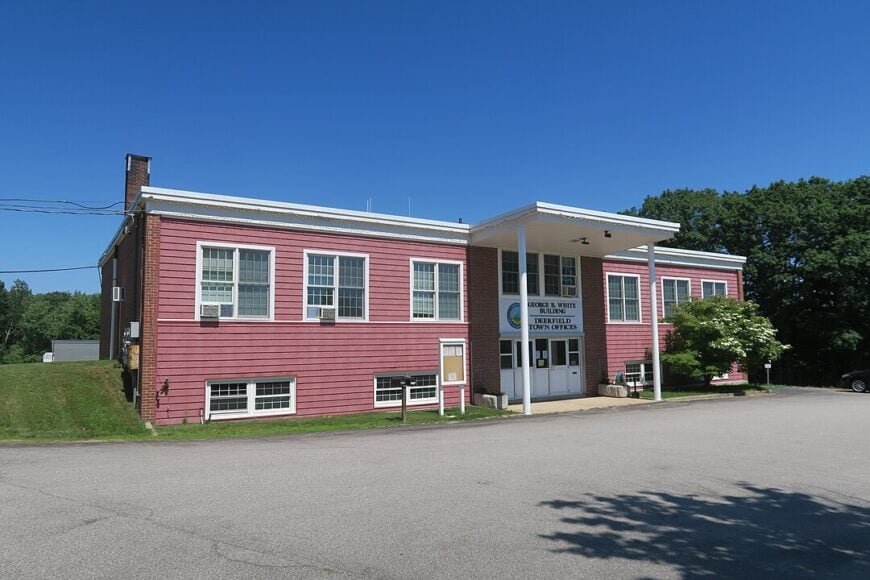
Deerfield, with a population of around 4,500, is a haven for those who appreciate expansive rural landscapes and a tight-knit community.
I love how the town’s rolling hills and open fields provide endless opportunities for hiking, horseback riding, and enjoying the outdoors. The annual Deerfield Fair, one of the oldest agricultural fairs in New England, brings the community together and celebrates the town’s farming heritage.
Despite its growth, Deerfield maintains a low population density, allowing residents plenty of space and privacy. The lack of commercial development and the abundance of conservation land make Deerfield a perfect spot for secluded living.
Where is Deerfield?
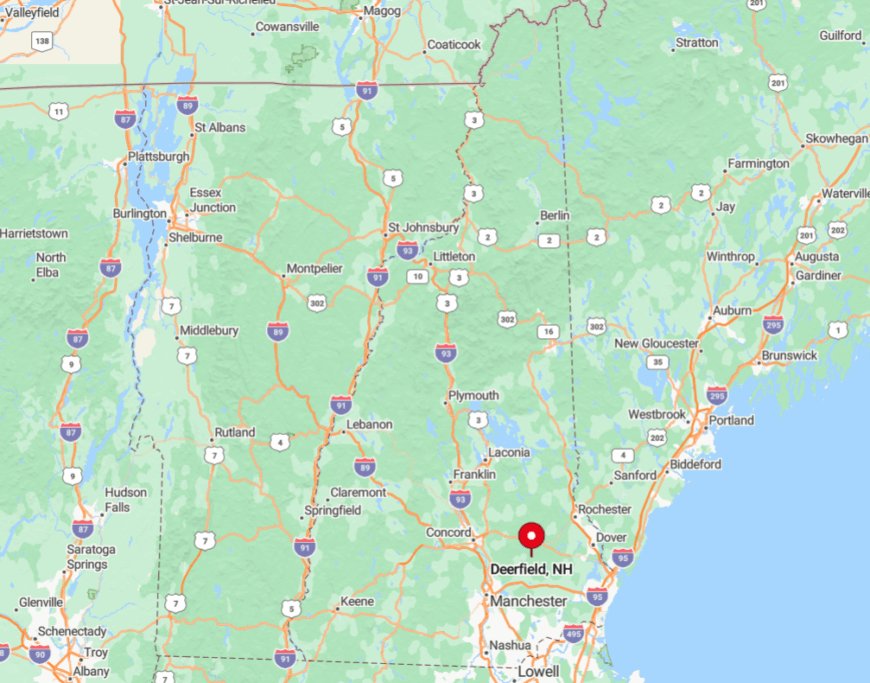
Nestled in Rockingham County, Deerfield is conveniently located about 20 miles northeast of Concord and 30 miles west of Portsmouth. Its location away from major highways contributes to its seclusion, as you have to take scenic back roads to reach it.
Surrounded by forests and farmlands, Deerfield feels worlds away from the bustle of city life. Getting there involves a tranquil drive through picturesque countryside, which is one of the things I enjoy most about visiting this charming town.
9. Nottingham: Historical Seclusion with Natural Barriers
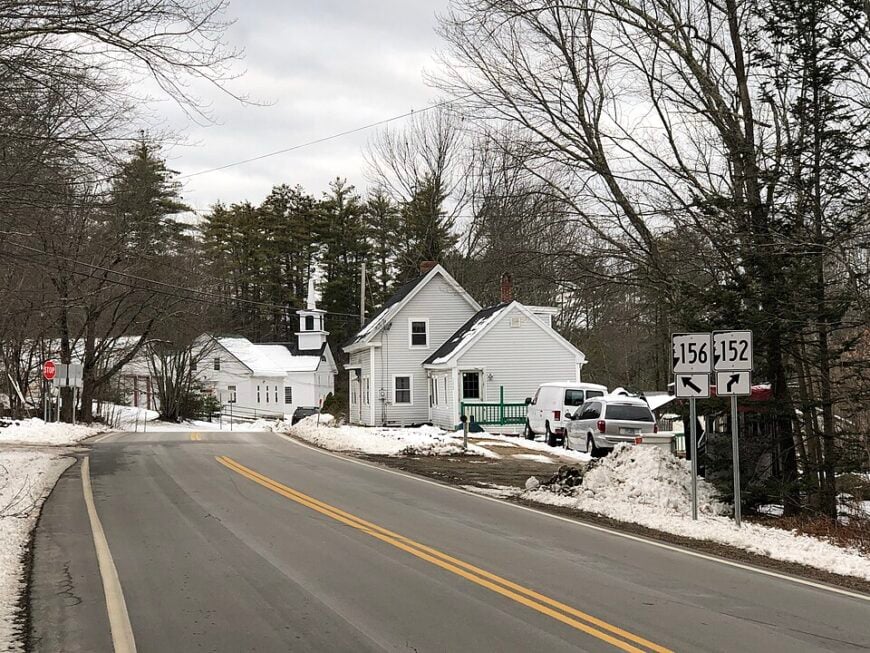
Nottingham is a quaint town with a population nearing 5,000, steeped in rich history dating back to its incorporation in 1722. I find its historical sites, like the Nottingham Square Historic District, fascinating to explore.
The town is dotted with beautiful lakes, including Pawtuckaway Lake, offering plenty of opportunities for boating, fishing, and camping in Pawtuckaway State Park.
Nottingham’s natural landscapes, consisting of dense forests and rolling hills, provide residents with ample privacy and a peaceful environment. The town’s commitment to preserving its natural beauty makes it an ideal spot for those seeking a secluded lifestyle.
Where is Nottingham?
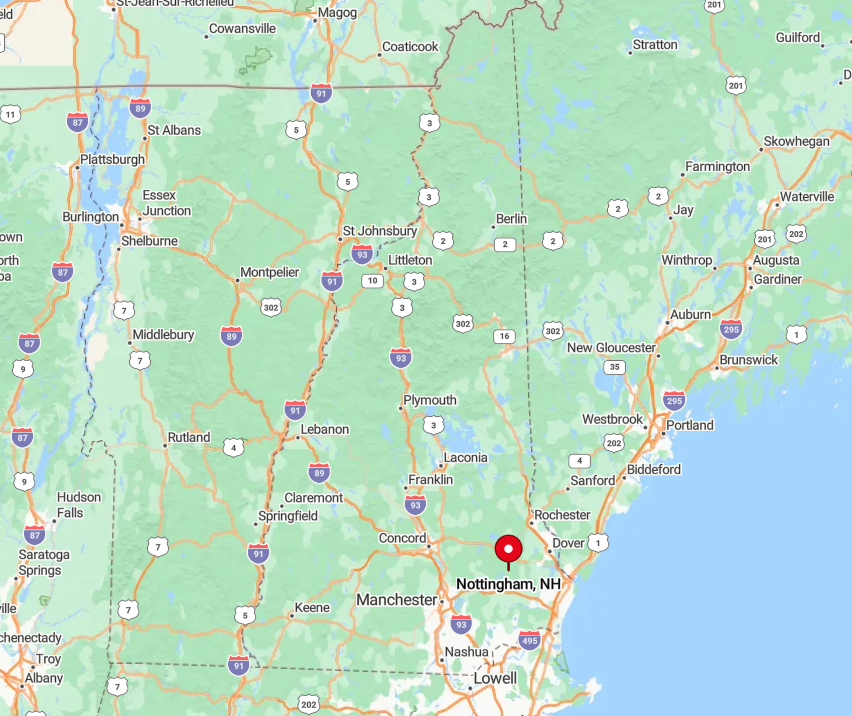
Located in Rockingham County, Nottingham sits approximately 25 miles east of Concord and 20 miles west of the seacoast. Its position away from major urban centers and highways enhances its secluded feel.
The town is surrounded by natural barriers like Pawtuckaway State Park, which adds to its sense of isolation from the surrounding areas. Reaching Nottingham involves a scenic drive through rural New Hampshire, making the journey as pleasant as the destination itself.
8. Lee: Rural Charm Just Beyond the City
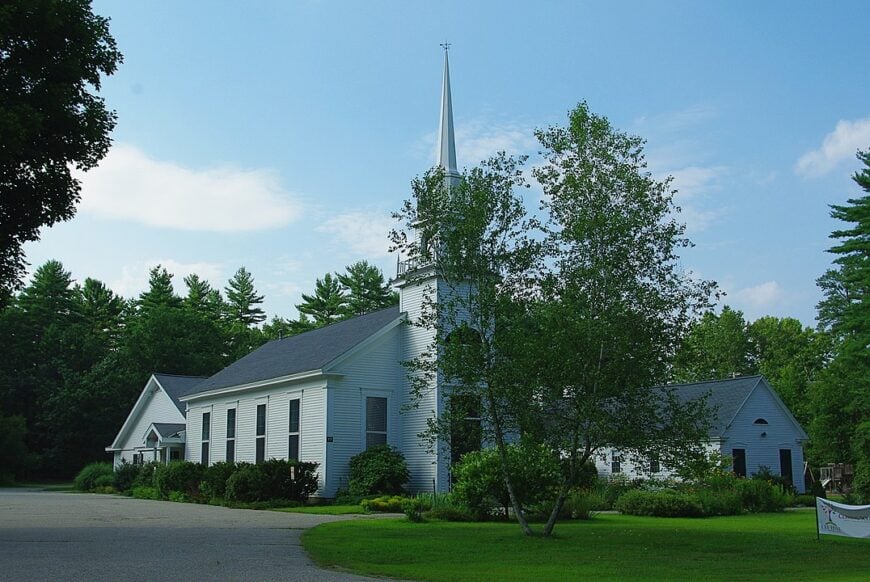
Lee is a small town with a population of about 4,500, offering a delightful blend of rural charm and accessibility. I appreciate how the town maintains large lot sizes and natural barriers, providing residents with privacy and space.
The charming Lee Town Center and Mast Way School reflect the town’s commitment to community and education.
Agricultural activities are prominent here, with local farms like Demeritt Hill Farm offering fresh produce and seasonal events. Lee’s extensive woodlands and conservation areas make it a haven for nature enthusiasts looking for a secluded yet connected place to call home.
Where is Lee?
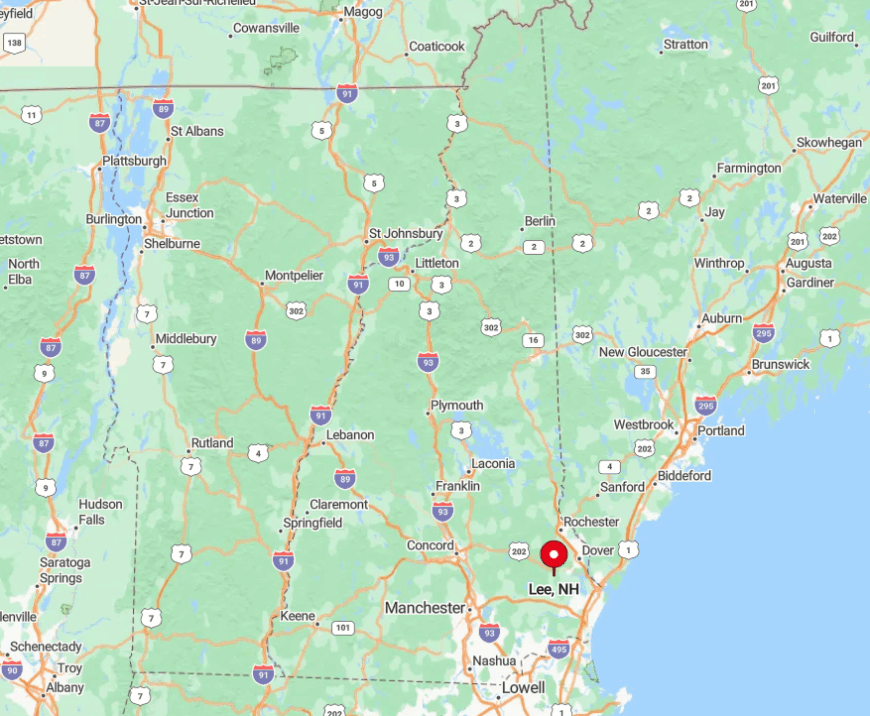
Situated in Strafford County, Lee is conveniently located near the University of New Hampshire in Durham, just 10 miles west of Portsmouth. Despite its proximity to more urban areas, Lee feels tucked away due to its rural landscapes and lack of major commercial development.
The town is easily accessible via Routes 4 and 125, yet its tree-lined roads and open spaces make it feel like a peaceful retreat. I often find that Lee’s balance of seclusion and convenience makes it a unique spot in Southeast New Hampshire.
7. Barrington: Peaceful Living Amongst Lakes and Forests

Barrington, home to around 9,000 residents, is known for its serene environment amidst numerous lakes and forests. I enjoy visiting Swains Lake and Ayers Pond for kayaking and fishing, as they offer a tranquil escape into nature.
The town’s rural setting is complemented by small local businesses and farms, like Calef’s Country Store, which adds to its quaint charm. Barrington’s sprawling forests and minimal urban development provide a peaceful setting, making it an ideal place for those seeking solitude among nature.
Where is Barrington?
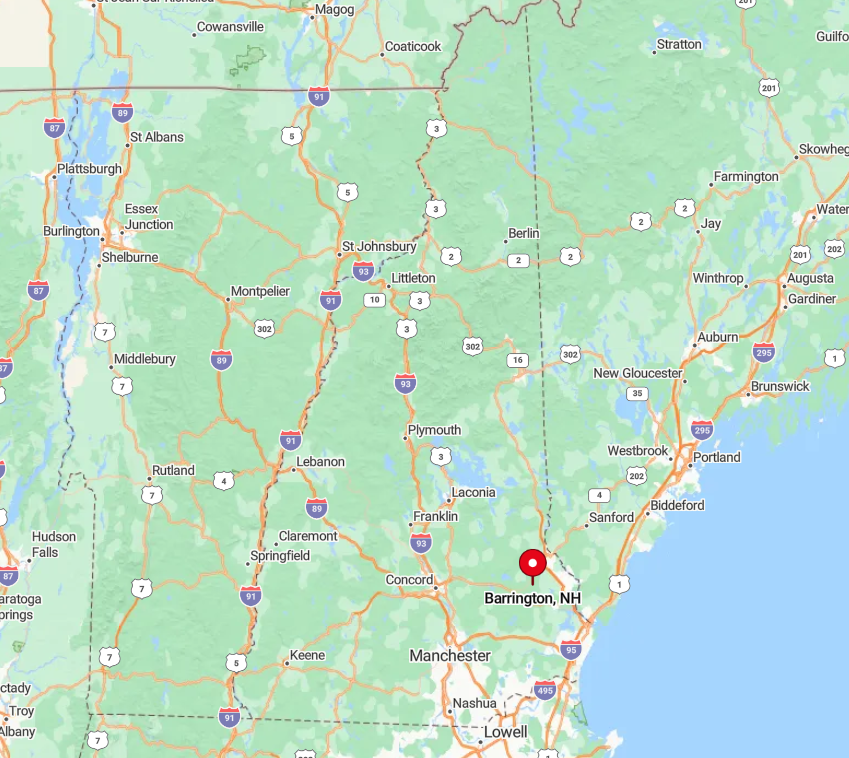
Located in Strafford County, Barrington lies about 15 miles northwest of Portsmouth and 20 miles east of Concord. The town’s seclusion is enhanced by its lack of major highways and its dense woodland areas.
Accessible via Route 125, getting to Barrington involves a leisurely drive through the countryside. I find that the journey itself, through the heart of New Hampshire’s natural beauty, contributes to the town’s secluded feel.
6. Northwood: Forested Seclusion in the Heart of New Hampshire

Northwood is a small town with approximately 4,200 residents, characterized by its extensive woodlands and tranquil lakes. I often explore Northwood Meadows State Park, a hidden gem perfect for hiking and wildlife observation. Antique shops line the town’s stretch of Route 4, giving it a unique charm.
The town’s rural landscapes and commitment to preserving natural areas provide residents with privacy and a deep connection to nature. Northwood’s sparse development and abundant forests make it a perfect spot for secluded living.
Where is Northwood?

Sitting in Rockingham County, Northwood is about 20 miles east of Concord and 30 miles west of Portsmouth. Its location along Route 4 provides easy access while still maintaining a sense of isolation due to the surrounding forests.
The town’s distance from larger cities and major highways enhances its secluded atmosphere. Reaching Northwood is a pleasant drive through scenic routes, which I always find relaxing and inviting.
5. Strafford: A Lakeside Retreat Away from It All
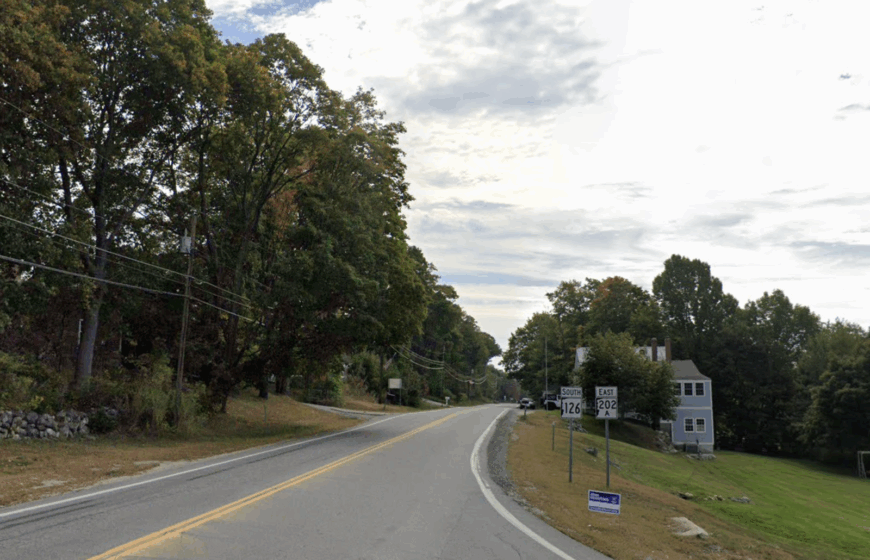
Strafford, with a population just over 4,000, is a picturesque town centered around the stunning Bow Lake. I love spending time here, whether it’s boating, fishing, or simply enjoying the serene lake views. The Blueberry Festival is a local favorite, celebrating the town’s agricultural roots.
With large tracts of undeveloped land and low housing density, Strafford offers a peaceful retreat from the noise of urban life. The town’s emphasis on preserving its natural beauty makes it an ideal spot for those seeking a secluded lakeside lifestyle.
Where is Strafford?
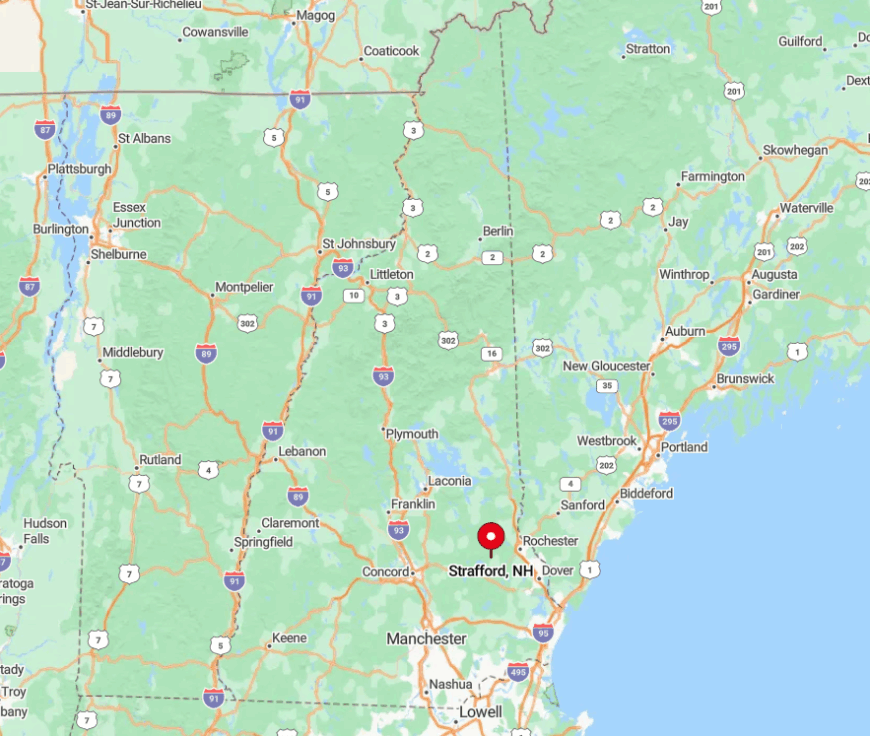
Located in Strafford County, Strafford is approximately 25 miles northeast of Concord and 20 miles northwest of Dover. The town’s secluded feel is enhanced by its surrounding hills and forests that act as natural barriers.
Accessed primarily via Route 202A, getting to Strafford involves a scenic drive through rural landscapes. I find that the peaceful roads leading into town set the tone for the tranquil experience Strafford offers.
4. Newfields: Quaint Village Living with Ample Space
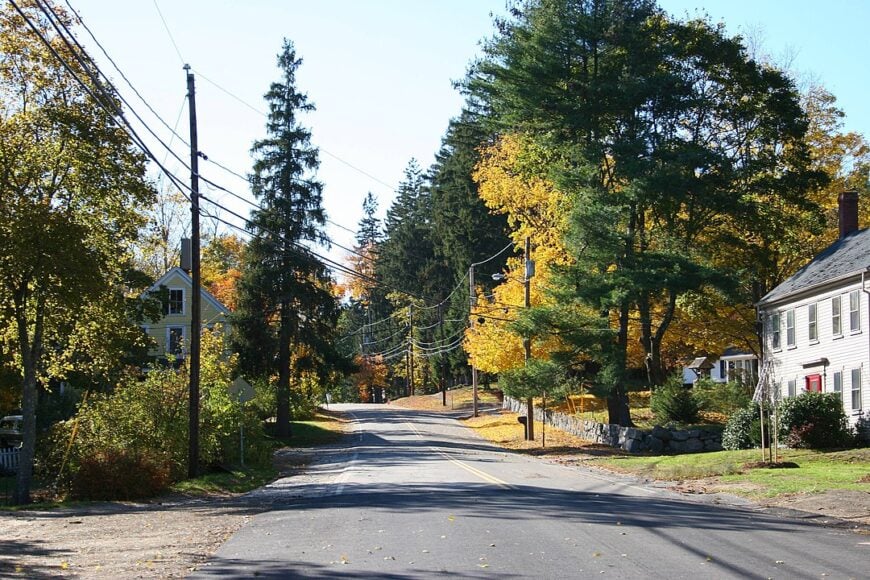
Newfields is a historic town with a population close to 1,700, offering quaint village charm and spacious surroundings. I enjoy strolling through the town’s historic district, where well-preserved 18th and 19th-century homes tell tales of the past.
The Schoppmeyer Memorial Trail is one of my favorite spots for a peaceful walk along the Exeter River. Newfields’ large property sizes and low population density provide residents with plenty of space and privacy. The town’s peaceful atmosphere makes it a perfect place for those looking to escape the crowded suburbs.
Where is Newfields?
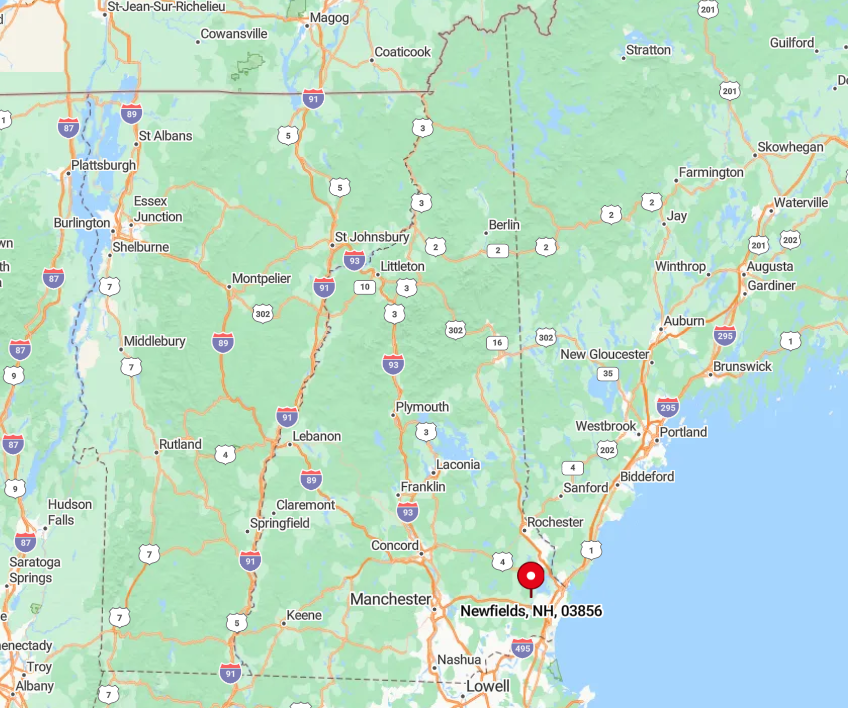
Situated in Rockingham County, Newfields is about 10 miles northwest of Portsmouth and easily accessible via Route 108. Despite its proximity to larger towns, Newfields maintains a secluded feel due to its small size and rural surroundings.
The town is tucked away along the river, enhancing its sense of tranquility. Reaching Newfields is a short drive through charming countryside, making it feel pleasantly removed from the hustle and bustle.
3. South Hampton: Coastal Seclusion Close to the Seacoast

South Hampton is a small town with a population of just over 800, offering a secluded environment near the coast without the typical tourist crowds.
I appreciate the town’s rural charm, with its historic homes and quiet roads perfect for leisurely bike rides. The Powwow River runs through South Hampton, providing scenic spots for fishing and picnicking.
Agriculture plays a significant role here, with local farms like Jewell Towne Vineyards adding to the town’s unique appeal. The limited commercial development and expansive open spaces make South Hampton a tranquil coastal retreat.
Where is South Hampton?
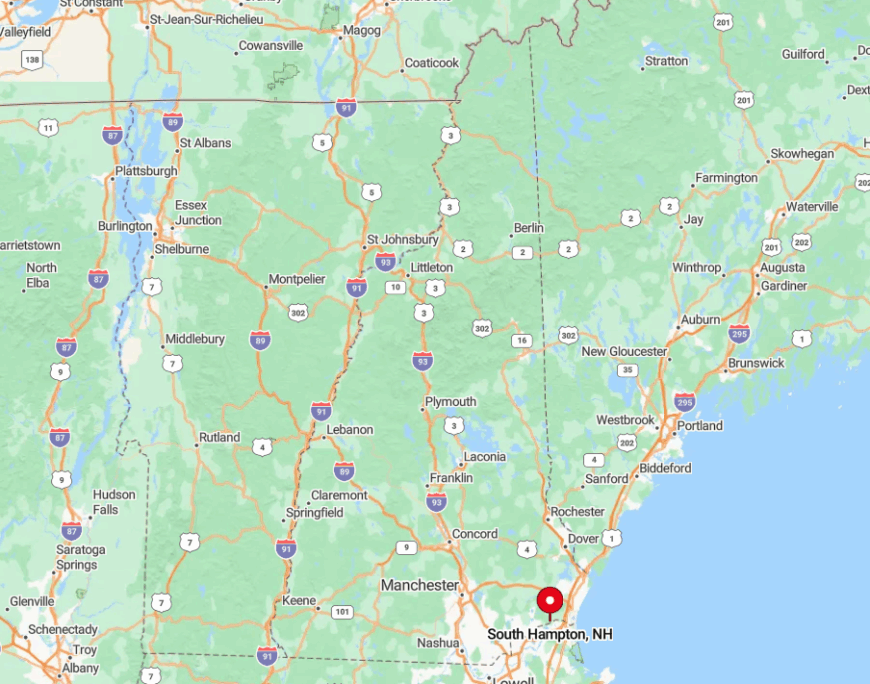
Located in Rockingham County, South Hampton sits along the Massachusetts border, about 20 miles south of Portsmouth. Its position away from major highways contributes to its sense of seclusion.
Accessed via Route 107A, the drive to South Hampton is filled with scenic views of rural landscapes. I find that its proximity to the seacoast, yet absence of bustling tourist activity, gives South Hampton a unique secluded charm.
2. Kensington: Serenity Amidst Nature’s Beauty
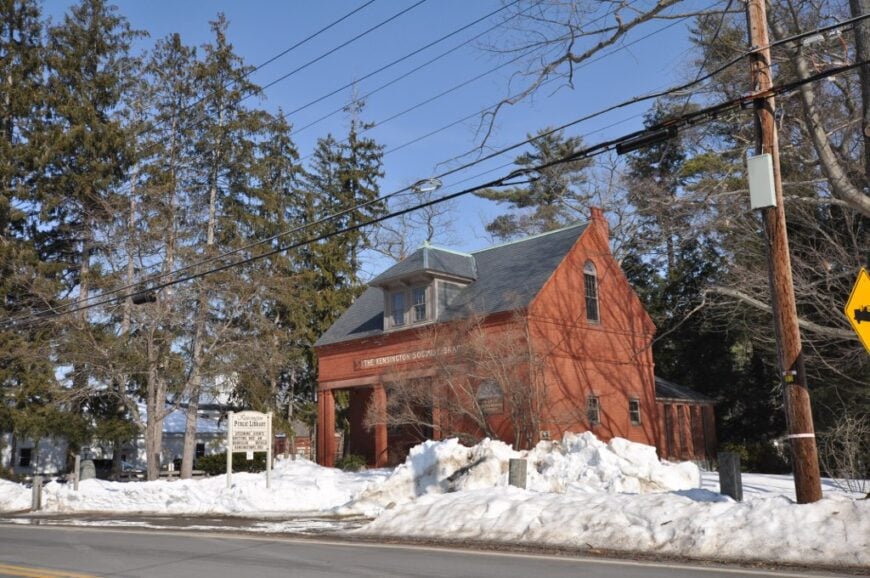
Kensington is a tranquil town with a population of around 2,300, known for its abundant natural landscapes and low population density. I enjoy visiting Kensington’s Sawyer Park, a community spot for recreation and enjoying the outdoors.
The town’s rural character is preserved through its expansive conservation areas, which offer plenty of space for hiking and wildlife watching. With few commercial establishments, Kensington provides a quiet, private environment that’s perfect for those seeking a close connection with nature.
Where is Kensington?
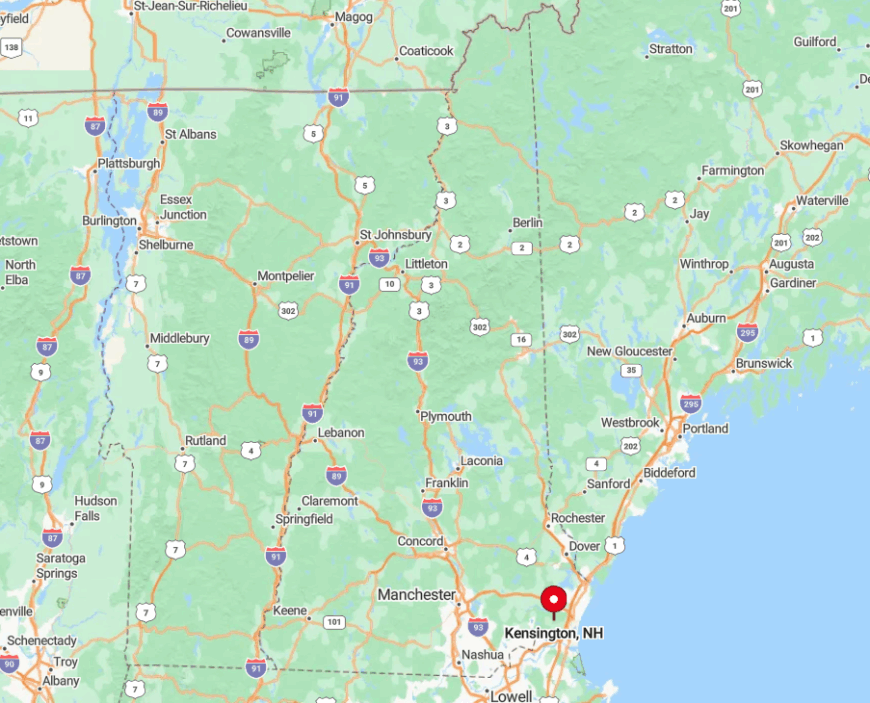
In Rockingham County, Kensington is located approximately 15 miles southwest of Portsmouth and just north of the Massachusetts border. Its seclusion is enhanced by its lack of major roadways passing through town.
Accessible primarily via local roads, reaching Kensington means taking a peaceful drive through New Hampshire’s countryside. I appreciate how the town’s natural barriers and rural charm make it feel like a serene escape from nearby urban areas.
1. East Kingston: A Hidden Gem Nestled Among Rolling Hills
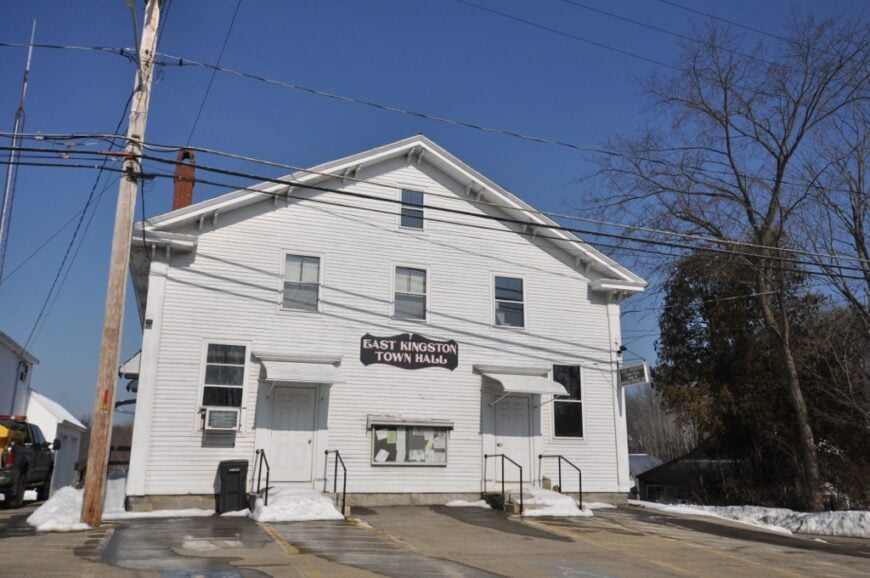
East Kingston, with a population of about 2,400, is truly one of Southeast New Hampshire’s hidden gems. The town is surrounded by lush greenery and rolling farmland, offering a peaceful rural lifestyle that I find incredibly appealing.
East Kingston’s small community is centered around its historic town center, featuring classic New England architecture.
The nearby Powwow River adds to the town’s picturesque scenery, providing opportunities for fishing and quiet reflection. The lack of commercial development and the abundance of open space make East Kingston exceptionally secluded.
Where is East Kingston?
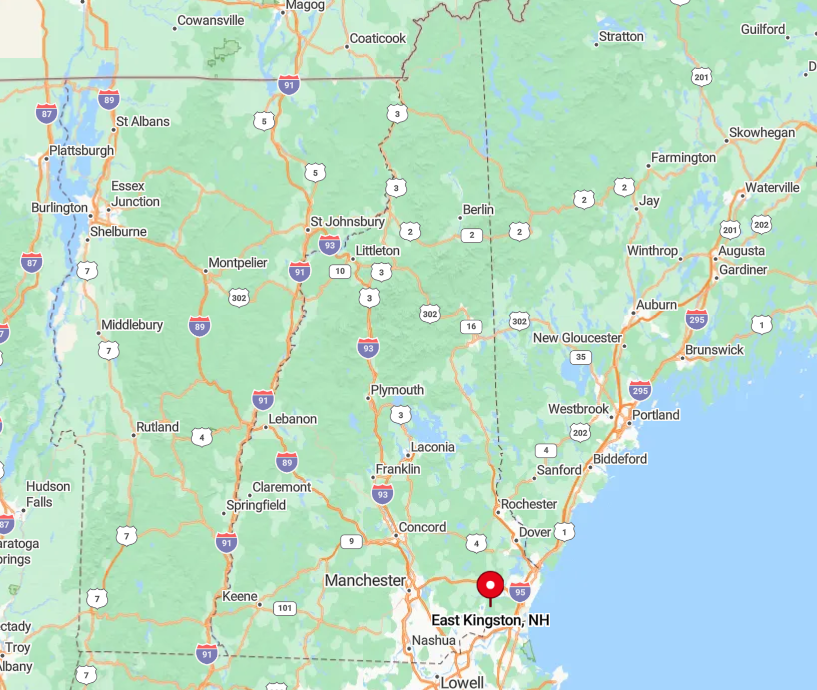
Situated in Rockingham County, East Kingston lies approximately 17 miles south of Portsmouth and near the Massachusetts border. Its location off the main highways enhances its sense of seclusion.
To get there, you take scenic local roads that weave through the countryside, which I always find to be a relaxing journey. Surrounded by natural landscapes and with few through roads, East Kingston feels like a peaceful haven tucked away among the rolling hills of New Hampshire.

